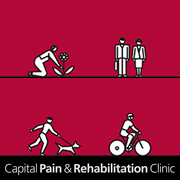Medical Intervention
At Capital Pain and Rehabilitation Clinic, we offer advanced medical interventions designed to target and manage pain effectively. Our specialised treatments include facet joint injections, zygapophysial joint medial branch nerve blocks, sacroiliac joint injections, all joint injections including hyaluronic acid and PRP, nerve blocks of upper and lower limb and torso including carpal tunnel, epidural injections for pain, radiofrequency neurotomy-thermal and pulsed, provocation discography, intradiscal therapies including transdiscal biacuplasty, and percutaneous disc decompression by Coblation Nucleoplasty, Spinal Cord Stimulation trials and implants and Peripheral Nerve Field Stimulation trials and implants.
A wide-variety of medical options means we are more likely to find the solution to your pain problem. These highly specialised interventions are always undertaken using specialised imaging guidance.
Pain Interventions available at Capital Pain and Rehabilitation Clinic
- Procedures are performed with precision under c-arm fluoroscopy and ultrasound
- Many procedures available in rooms, not requiring added hospital stay
About
Facet joint injections are a minimally invasive procedure used to diagnose and treat pain caused by the facet joints in the spine, which are the small joints located between the vertebrae. These joints are responsible for allowing the spine to bend and twist. When they become inflamed or degenerated due to conditions like arthritis, injury, or spinal stenosis, they can cause significant pain, stiffness, and limited mobility in the neck, upper back, or lower back.
The procedure involves injecting a local anaesthetic and corticosteroid directly into the facet joint, which helps to reduce inflammation, numb the area, and alleviate pain. The corticosteroid provides longer-lasting relief by reducing swelling and irritation around the joint, while the anaesthetic provides immediate pain relief. Facet joint injections can also serve as a diagnostic tool, helping healthcare providers confirm whether the facet joints are the source of pain before moving forward with additional treatments.
At Capital Pain and Rehabilitation Clinic, we use guided imaging techniques such as fluoroscopy or ultrasound to ensure accurate needle placement, making the procedure safer and more effective. Facet joint injections can offer significant relief for patients suffering from chronic back pain and help them return to daily activities with improved movement and reduced pain.
Benefits
Facet joint injections are highly effective for providing targeted pain relief in individuals suffering from chronic back pain, especially in the neck, upper back, or lower back. The injections deliver local anaesthetic and corticosteroid directly into the facet joints to help reduce inflammation and numb the area, providing immediate pain relief and long-lasting benefits. For many patients, facet joint injections help alleviate pain caused by conditions such as arthritis, spinal stenosis, or facet joint degeneration, allowing them to regain mobility and improve their quality of life. In addition to relieving pain, these injections can help improve range of motion, enabling patients to participate in rehabilitation and daily activities more comfortably. Facet joint injections can also act as a diagnostic tool, confirming whether the facet joints are the true source of the pain before proceeding with other treatments.
Risks
Although facet joint injections are generally safe, there are some risks involved. Temporary pain, swelling, or bruising at the injection site is common, and some individuals may experience mild discomfort as the anaesthetic wears off. Rarely, patients may experience more serious side effects, including infection, allergic reactions, bleeding, or nerve damage. There is also a risk of temporary numbness or weakness in the treated area. While the corticosteroid medication helps reduce inflammation and pain, frequent injections may lead to tissue damage or weakened bones over time. Therefore, these injections are typically performed as part of a broader pain management plan and are not intended for long-term use.
Who is eligible?
Facet joint injections are suitable for individuals suffering from chronic back pain related to facet joint inflammation, arthritis, or degeneration. They are particularly beneficial for individuals who have not found relief from other treatments such as medications, physical therapy, or other conservative measures. Facet joint injections are an option for patients with neck or back pain, often accompanied by stiffness or limited movement, caused by conditions like spinal stenosis, spondylosis, or facet joint syndrome. However, they may not be suitable for individuals with active infections, certain medical conditions like bleeding disorders, or osteoporosis. A consultation with a specialist at Capital Pain and Rehabilitation Clinic is necessary to determine if facet joint injections are appropriate for a patient’s specific condition and health status.
Facet Joint injections
The procedure involves injecting a local anaesthetic and corticosteroid directly into the facet joint, which helps to reduce inflammation, numb the area, and alleviate pain.


Zygapophysial (‘facet’) and sacroiliac joint injections or ‘blocks’
Chronic persistent pain can arise from any one of a number of sources in the patients back or neck.
About
Sometimes it may be possible to pinpoint this to one or more joints of the spine (these are called zygapophysial joints, or incorrectly, facet joints). The fine-needle injection provides useful information about potentially problematic joints that help to guide the treatment approach. The zygapophysial joint injection is used primarily for diagnostic purposes and is not necessarily therapeutic in nature. However, if the block is successful and it breaks the pain cycle, up to a third of people having the injection notice a useful reduction in the severity of pain for a period of hours, days or weeks.
The procedure to identify such a joint is relatively simple and quite safe but does require the use of an x-ray machine to be able to localise the location of the fine nerves to the joint with accuracy and reliability. Pain arising from these joints cannot be reliably of relatively diagnosed by any other means (including CT scan, MRI scan or bone scan). X-ray controlled diagnostic blocks are the only means available of identifying this source of pain.
Benefits
Confirmation that you may or may not have symptomatic zygapophysial or sacroiliac joints causing you your persistent pain. This may be the first time that you have been given a specific diagnosis, and importantly this is a diagnosis that allows you to consider having the safe, simple and very commonly performed therapeutic procedure of thermo-coagulative radiofrequency neurotomy of those joints to provide, an average 8 to 18 months of pain relief.
Risks
The procedure is very safe, although as with any injections, there is a very small risk of:
- infection
- bleeding
- allergic reaction
Other:
- there is some radiation exposure from the x-rays which has been described as equivalent to a 1-hour plane flight.
- The main side effect is some soft tissue soreness from the needles, but this usually wears off within hours. The procedure can be thought of as similar to a dental injection.
The procedure
A minimum of two sessions of injections are usually required in a series, in which local anaesthetic is used. The patient then reports if they experienced any pain relief and if so, how long it lasted. We recommend a 2nd injection to strengthen the likelihhod that the joint is a source of your pain.
Guided by a special manoeuvrable low-dose x-ray machine a fine needle is directed to the target point at 2 or 3 locations with Local Anaethetic, with or without cortisone. Procedure time is approximately 10-20 minutes.
It is important that patients understand no pain relief may come from the injection, but this is still useful information as it implies that that joint(s) is not the source of your pain and we should look at the next one.
Post procedure
It is preferable to have someone drive you home.
Patients may experience some local soft tissue soreness from having had needles in the back or the neck. Simple analgesics or ice may be used for this soreness. Patients are encouraged to try and differentiate this pain from their normal underlying pain problem for which they had the injection.
Please carefully consider the relief or non-relief of the underlying pain and diligently complete the Pain Charts. Has some part of your pain completely gone, and if so for how long? This documentation is very important for discussions later on concerning the effectiveness of the injections.
If relief occurs you should carefully attempt to move into some activities of daily living that are normally restricted by pain, but within reasonable limits and record these movements and activities for future discussion.
Things we need to know
Please inform staff if;
- You have any medication or contrast allergies
- You take any blood thinning medication
- Female patients: if you are pregnant, suspect you may be pregnant or breatfeeding.
About
Sacroiliac (SI) joint injections are a minimally invasive procedure used to diagnose and treat pain originating from the sacroiliac joint, which connects the spine to the pelvis. These injections are particularly beneficial for patients experiencing lower back, buttock, or hip pain due to conditions such as sacroiliac joint dysfunction, arthritis, injury, or inflammation.
The procedure involves injecting a local anaesthetic and corticosteroid medication into the sacroiliac joint to reduce pain and inflammation, providing relief and improving mobility. In some cases, SI joint injections are also used as a diagnostic tool to confirm whether the joint is the source of pain before proceeding with further treatments.
At Capital Pain and Rehabilitation Clinic, our specialists perform guided SI joint injections using advanced imaging techniques to ensure precision and effectiveness. This safe and effective treatment allows patients to regain movement, participate in rehabilitation, and manage their pain with minimal downtime.
Benefits
Sacroiliac (SI) joint injections provide targeted pain relief for individuals suffering from lower back, buttock, or hip pain caused by sacroiliac joint dysfunction, arthritis, injury, or inflammation. By injecting a local anaesthetic and corticosteroid into the joint, the procedure helps reduce pain, decrease inflammation, and improve mobility. This minimally invasive treatment allows patients to return to daily activities with minimal downtime. Additionally, SI joint injections serve as a diagnostic tool, helping healthcare providers confirm whether the sacroiliac joint is the source of pain before recommending further treatments or interventions.
Risks
Although SI joint injections are generally safe, there are potential risks to consider. Some patients may experience temporary soreness, swelling, or bruising at the injection site. In rare cases, there is a risk of infection, nerve damage, allergic reactions, or bleeding. While corticosteroid injections provide relief, the duration of effectiveness can vary, and repeated injections may be needed for long-term management. Additionally, frequent corticosteroid use may lead to weakened joint structures or temporary increases in blood sugar levels, particularly in diabetic patients.
Who is eligible?
SI joint injections are recommended for individuals experiencing chronic or acute lower back, hip, or buttock pain related to sacroiliac joint dysfunction, arthritis, or injury. They are particularly beneficial for those who have not responded to medications, physiotherapy, or other conservative treatments. However, patients with active infections, bleeding disorders, or certain medical conditions may not be suitable candidates. A consultation with a specialist at Capital Pain and Rehabilitation Clinic will help determine whether SI joint injections are the right treatment option for each patient’s unique needs.
Sacroiliac Joint Injections
Sacroiliac (SI) joint injections are a minimally invasive procedure used to diagnose and treat pain originating from the sacroiliac joint.

All Joint Injections Including Hyaluronic Acid and PRP
Injection to help lubricate and cushion the joints, reducing stiffness and discomfort.

About
At Capital Pain and Rehabilitation Clinic, we offer a range of joint injections to help manage pain, reduce inflammation, and improve joint function for conditions such as osteoarthritis, tendon injuries, and joint degeneration. Our treatments include Hyaluronic Acid (HA) injections, which help lubricate and cushion the joints, reducing stiffness and discomfort, and Platelet-Rich Plasma (PRP) therapy, a regenerative treatment that uses the patient’s own blood components to promote healing and tissue repair. These minimally invasive procedures provide an effective alternative for patients seeking relief from joint pain without surgery, helping to enhance mobility and overall quality of life.
Benefits
Joint injections, including Hyaluronic Acid (HA) and Platelet-Rich Plasma (PRP) therapy, offer an effective, non-surgical solution for managing joint pain and improving mobility. These treatments help reduce inflammation, alleviate discomfort, and restore joint function for conditions such as osteoarthritis and tendon injuries. Hyaluronic Acid injections act as a lubricant and shock absorber within the joint, enhancing movement and reducing stiffness. PRP therapy, on the other hand, harnesses the body’s natural healing processes by using a concentrated form of the patient’s own blood components to promote tissue repair and regeneration. These minimally invasive procedures allow patients to regain mobility and improve their quality of life without the need for surgery.
Risks
While joint injections are generally safe, there are some potential risks to consider. Patients may experience temporary swelling, discomfort, or mild pain at the injection site. In rare cases, there is a risk of infection or an allergic reaction, particularly with HA injections. The effectiveness of the treatment can also vary between individuals, and some patients may require repeat injections to maintain long-term relief. Additionally, while PRP therapy promotes natural healing, the results are not immediate, and multiple sessions may be needed to achieve optimal outcomes.
Who is elgible?
Joint injections are suitable for individuals with mild to moderate osteoarthritis, joint degeneration, or tendon injuries who are looking for an alternative to surgery. They are particularly beneficial for athletes and active individuals recovering from injuries, as well as those who have not responded well to other treatments, such as physiotherapy or pain medication. However, these injections may not be suitable for individuals with active infections, severe joint damage, or certain blood disorders. A consultation with a specialist at Capital Pain and Rehabilitation Clinic is essential to determine the most appropriate treatment plan based on each patient’s specific needs and health condition.
About
Nerve blocks are a minimally invasive procedure used to relieve pain by targeting specific nerves in the upper and lower limbs, as well as the torso. These injections are particularly beneficial for patients suffering from acute or chronic pain caused by conditions such as nerve compression, injury, inflammation, or certain conditions like carpal tunnel syndrome. A local anaesthetic or corticosteroid is injected near the affected nerve to block pain signals, providing immediate relief and allowing patients to regain mobility and function.
One of the most common nerve blocks is for carpal tunnel syndrome, which occurs when the median nerve in the wrist is compressed, leading to pain, numbness, or tingling in the hand and fingers. A carpal tunnel nerve block can provide temporary relief and is often used as part of a broader treatment plan for individuals who have not responded to conservative measures like splinting or physiotherapy.
Nerve blocks can also be used for pain relief in other areas, including the shoulder, arm, leg, and torso, helping to manage pain from conditions like herniated discs, sciatica, or thoracic outlet syndrome. At Capital Pain and Rehabilitation Clinic, our specialists use guided imaging techniques to ensure precision and effectiveness when administering nerve blocks, offering patients a safe, effective solution for pain management.
These treatments can provide significant and long-lasting relief, helping patients reduce reliance on medications and improve their quality of life. In some cases, nerve blocks can also act as diagnostic tools, helping to pinpoint the source of pain before proceeding with more invasive treatments.
Benefits
Nerve blocks are a highly effective pain management technique for patients suffering from conditions affecting the upper and lower limbs or torso. These injections offer targeted pain relief by blocking pain signals from specific nerves, helping to manage chronic or acute pain caused by nerve compression, inflammation, or injury. One of the most common applications is for carpal tunnel syndrome, where a nerve block can provide immediate relief from pain, numbness, and tingling in the wrist and hand. Nerve blocks can also be used to treat shoulder, arm, leg, or torso pain, offering relief from conditions like sciatica, thoracic outlet syndrome, and herniated discs. These procedures help reduce the need for medications and can improve mobility and quality of life by providing long-lasting relief. Additionally, nerve blocks can be used as a diagnostic tool to help identify the source of pain and inform treatment plans.
Risks
While generally safe, nerve blocks do carry some risks. Patients may experience temporary pain, swelling, or bruising at the injection site. In rare cases, there may be a risk of infection, nerve damage, bleeding, or allergic reactions to the medication. Some patients might experience temporary numbness or weakness in the area being treated, although these side effects typically subside once the anaesthetic wears off. While nerve blocks can provide effective pain relief, the effects are temporary, and multiple injections may be needed for sustained relief. In very rare instances, there may be more serious complications, such as damage to surrounding tissues or nerves, but these are uncommon when performed by experienced practitioners.
Who is eligible?
Nerve blocks are suitable for individuals experiencing chronic pain or acute pain in the upper or lower limbs or torso, caused by conditions such as carpal tunnel syndrome, sciatica, thoracic outlet syndrome, or nerve compression from herniated discs. These injections are particularly helpful for individuals who have not found relief from medications, physical therapy, or other conservative treatments. Nerve blocks can also be a useful option for patients preparing for surgical intervention or those looking to avoid surgery. However, nerve blocks may not be suitable for individuals with active infections, bleeding disorders, or certain neurological conditions. A comprehensive consultation with a specialist at Capital Pain and Rehabilitation Clinic is necessary to determine if nerve blocks are the right treatment option based on the patient’s unique condition and medical history.
Nerve Blocks of Upper and Lower Limb and Torso Including Carpal Tunnel
Nerve blocks are a highly effective pain management technique for patients suffering from conditions affecting the upper and lower limbs or torso.

Epidural Injections for Pain
Epidural injections are a minimally invasive treatment used to relieve pain caused by spinal conditions such as herniated discs, spinal stenosis, sciatica, and nerve inflammation.

About
Sometimes it may be possible to pinpoint this to one or more joints of the spine (these are called zygapophysial joints, or incorrectly, facet joints). The fine-needle injection provides useful information about potentially problematic joints that help to guide the treatment approach. The zygapophysial joint injection is used purely for diagnostic purposes and is not therapeutic in nature. However, if the block is successful and it breaks the pain cycle, up to a third of people having the injection notice a useful reduction in the severity of pain for a period of days or weeks.
The procedure to identify such a joint is relatively simple and quite safe but does require the use of an x-ray machine to be able to localise the location of the fine nerves to the joint with accuracy and reliability. Pain arising from these joints cannot be reliably of relatively diagnosed by any other means (including CT scan, MRI scan or bone scan). X-ray controlled diagnostic blocks are the only means available of identifying this source of pain.
Benefits
Epidural injections provide targeted pain relief for individuals suffering from chronic back, neck, or leg pain caused by conditions such as herniated discs, spinal stenosis, sciatica, and nerve inflammation. By delivering a combination of corticosteroids and local anaesthetic directly into the epidural space around the spinal nerves, these injections help reduce inflammation, relieve nerve compression, and improve mobility. The procedure is minimally invasive, requiring little to no downtime, and can allow patients to delay or avoid surgery while improving their ability to participate in rehabilitation and daily activities. For many, epidural injections provide long-lasting pain relief, enabling a better quality of life.
Risks
While generally safe, epidural injections do carry some risks. Some patients may experience temporary soreness, bruising, or discomfort at the injection site. In rare cases, there is a risk of infection, nerve damage, or bleeding. Side effects such as temporary numbness, dizziness, or headaches may also occur. Although corticosteroid injections provide effective pain relief, the duration of relief varies between individuals, and repeat injections may be needed. Long-term or frequent use of corticosteroids can weaken bones and tissues, elevate blood sugar levels, or suppress the immune system, which is why their use is carefully managed.
Who is eligible?
Epidural injections are suitable for individuals experiencing chronic or acute spinal pain due to nerve inflammation, herniated discs, spinal stenosis, or sciatica. Patients who have not responded to medications, physiotherapy, or other conservative treatments may benefit from this procedure. However, epidural injections may not be suitable for those with active infections, bleeding disorders, uncontrolled diabetes, or severe osteoporosis. A consultation with a specialist at Capital Pain and Rehabilitation Clinic is essential to determine whether epidural injections are the right treatment option based on each patient’s specific condition and medical history.
About
Radiofrequency neurotomy (RFN), sometimes called ablation, is a simple pain relieving minor surgical procedure. It is a procedure carried out under imaging guidance using x-ray or ultrasound to place a fine needle called an electrode using local anaesthetic alongside a relevant small nerve. The needle tip is then heated to 80 C and coagulates the nerve, thus rendering it dysfunctional. This does not destroy the nerve but prevents the nerve from functioning and thereby pain messages are stopped until the treated nerves regrow. This can take from three to eighteen months depending on the size and length of the coagulation zone and the nerve.
The procedure is carried out as a simple day-only procedure in a hospital or appropriate facility such as our clinic. Local anaesthetic is used along with or without light sedation if needed.
It is the world's commonest pain procedure, and has been scientifically proven to be a safe and effective means of useful pain relief for many of these patients around the world.
Benefits
There is a better than 70% likelihood of obtaining relief similar to that found during the diagnostic procedures. The duration of responses has varied from three months to eighteen months with an average of seven months.
A good result will allow the patient to reduce or cease medications and therapy and increase their ability to undertake a wider range of activities.
Risks
- Small risk of infection or allergic reaction to local anaesthetic.
- There may be significant post-operative localised pain lasting two days to two weeks and which may feel like a deep bruise, similar to a severe thumping in the neck or back, but this is easily managed with analgesics and ice or heat packs and gentle exercise.
- Risk of developing an area of hypersensitive ‘sunburn’ skin for days or weeks. This can range from a minor nuisance to a burning hypersensitivity which can be quite disabling but these can be made manageable with medications, steroid injection and ointments.
- There is a potential risk of damaging other tissues such as bone lining, ligaments, joint capsules and other tissues and this is why the pain can be significant for some time. It is also feasible to inadvertently damage other nerves if inadequate visualisation with x-ray has not been obtained. However, this is unlikely to occur specially when you remain somewhat awake throughout the procedure and may warn of inadvertent pain.
- There is further radiation exposure which may be equivalent to the background radiation exposure of "several return trips to Europe".
- There may be a few hours or days of dizziness and/or unsteadiness, particularly if the upper cervical joint is treated.
- The procedure may fail in as many as 30 percent of patients, often for technical reasons, or in reality a less than perfect diagnosis. A repeat attempt may be warranted should the initial procedure provide insufficient relief.
- Eventual failure of the procedure. There is a buildup of fine scar tissue adjacent to the nerve on the previous procedures. It is not known how many times radio frequency can be successfully repeated; some individuals have had ten to twelve successful repetitions.
Who is eligible for RFN?
In general terms we recommend this for patients who have
- persistent,
- severe,
- disabling pain
- for which other simpler treatments have been ineffective and
- for which they would like a more effective treatment.
They will have an adequately diagnosed condition, such as painful spinal zygapophysial joints (by means of diagnostic nerve blocks where they have had definite or complete relief repeatedly), nerve scars or nerve entrapment. We undertake these diagnostic approaches through this Clinic in preparation for neurotomy.
What are the treatment alternatives?
For a proven zygapophysial joint problem there is no alternative as effective. However, many people find benefit in medications, exercises, manipulation or mobilisation, physiotherapy techniques, pain management psychology, osteopathy, chiropractic, acupuncture, massage and other forms of treatment. Using one of these approaches as available at this Clinic may be all that you need to feel comfortable and cope with your pain.
Can RF be repeated?
Yes. If other measures are insufficient to control otherwise unrelievable pain and the patient reports sufficient benefit from the previous procedures, this procedure can be repeated successfully in most patients.
However, if the first procedure is ineffective, that is if it does not work at all, then a repeat attempt has not yet been shown to be successful. However, if pain relief is incomplete or of short duration such as days or weeks then there is a 30-50 percent chance of a repeat procedure being more successful.
Post procedure
You will be discharged from hospital when you are ready. You will need transport – it is not appropriate that you drive. If you have had sedation then you cannot drive or sign legal documents for 24 hours. However, most people can travel by car or plane for several hours after the procedure.
The patient will be supplied a prescription for strong analgesics, and it is recommended that you use ice packs, and to lightly exercise your spine to prevent secondary tightness which can then cause further pain.
The patient is instructed to be followed up by your treating general practitioner and/or referring specialist. If Dr. Speldewinde has not personally reviewed the patient, it is recommended that he be informed one month after the procedure as to the patient’s progress or sooner if there are any questions.
Radiofrequency Neurotomy (RFN)
Radiofrequency neurotomy (RFN) is a simple pain relieving minor surgical procedure.

Discography
This procedure is performed for diagnostic purposes when an MRI picture is inconclusive as to the likely source of pain and your clinical findings does not clearly indicate a single specific disc as a source of pain.

About
This procedure is performed to attempt to clarify whether 1 or more discs are causing back pain especially when an MRI scan is inconclusive as to the likely source of pain. Moreover generally we have excluded the possibility of pain arising from a joint or joints in that area spine first of all.
Often a person has more than one symptomatic disc so with discography often three discs are tested by injecting them to see whether any pain is reproduced. Light sedation is often used to introduce a small needle into the target discs. Then, still using low-dose x-ray guidance a small amount of dye is injected with small measured pressure and your response to this pressure is noted. We like one disc to be painless with this procedure while one or two of the others may reproduce your back pain. This indicates that that 1 or 2 painful discs are a probable cause of your pain. With this information and you can consider the option of a minimally invasive nonsurgical therapeutic disc procedure such as percutaneous disc decompression by Coblation Nucleoplasty, or transdiscal biacuplasty. Of course you can also share that information with a spine surgeon should consideration be given to surgical techniques.
Benefits
An accurate and more specific confirmation of a symptomatic Internal Disc Disruption.
Risks
The major risks of provocation discography are highly uncommon, less than 1% incidence, but may include nerve damage, and importantly a deep infection in one of the discs which may require 6 to 12 weeks of antibiotics, including possibly 1 to 2 weeks initially in hospital having intravenous antibiotics.
Post procedure
Whilst we often can report a conclusive result, up to 50% of these procedures resulted in an "indeterminant finding" due to technical issues such as having a very disrupted disc, or not fully reproducing your usual back pain during the procedure.
About
We offer specialised minimally-invasive non-surgical disc procedures for separate diagnostic and therapeutic purposes. However these results may give you and your treating doctor better reason to occasionally consider spine surgery. These can certainly reduce your need for spine surgery.
Benefits
Disc procedures are often used to treat chronic back pain, herniated discs, and other spinal conditions. The benefits of disc procedures, which can include both non-surgical and surgical interventions, are:
- Pain Relief – Disc procedures, such as discography, discectomy, or epidural steroid injections, can effectively reduce pain caused by herniated or degenerated discs.
- Restored Functionality – Many patients experience improved mobility and reduced pain, allowing them to return to normal daily activities.
- Minimally Invasive Options – Some disc procedures, like minimally invasive discectomy or epidural injections, require smaller incisions, reducing the risk of complications and speeding up recovery.
- Reduced Need for Pain Medication – Successful disc procedures can reduce or eliminate the need for long-term pain medications, including opioids.
- Improved Quality of Life – With pain alleviation and improved movement, many patients report a better quality of life and greater ability to engage in physical activities.
- Long-Term Relief – Depending on the procedure, such as artificial disc replacement or spinal fusion, some patients experience long-lasting relief from chronic pain.
Risks
While disc procedures offer significant benefits, they are not without risks. The potential risks include:
- Surgical Complications – Invasive procedures like discectomy or spinal fusion carry risks of infection, bleeding, or nerve damage.
- Infection – As with any procedure involving the spine, there is a risk of infection at the surgical site or where injections are administered.
- Nerve Damage – There is a small risk of nerve injury during surgery, which could result in persistent pain, weakness, or numbness.
- Failure to Relieve Pain – Not all patients will experience significant pain relief, and in some cases, the procedure may not resolve the underlying issue.
- Scar Tissue Formation – In some cases, scar tissue may form around the surgical site, potentially leading to continued discomfort or nerve compression.
- Hardware Complications – If a spinal fusion or artificial disc replacement is performed, there may be complications with the implanted device, such as malfunction or displacement.
- Recovery Time – Some procedures, especially spinal fusion, can require a long recovery period and may involve rehabilitation and physiotherapy.
Who is eligible for disc procedures?
Patients who have persistent, severe, disabling pain for which other simpler treatments have been ineffective and for which they would like a more effective treatment are eligible. They will have an exclusion of painful spinal zygapophysial joints (by means of diagnostic nerve blocks where they have had definite or complete relief repeatedly), past operations, nerve scars or nerve entrapment, or medical conditions such as persistent nerve pain, widespread, or pelvic or abdominal pain.
Disc Procedures
We offer specialised minimally-invasive non-surgical disc procedures for separate diagnostic and therapeutic purposes.

Spinal And Peripheral Nerve Field Stimulation (SCS/PNS)
Mild electrical stimulation with SCS not only appears to reduce the amount of pain signals that travel in the spine, evidence suggests it also stimulates nerves to release pain-relief chemicals.

About
Stimulation therapies are provided by very fine electrical leads placed under the skin or in the spine in order to deliver very low intensity current. This current generally is set so that you cannot feel anything except pain relief. This procedure is often highly successful in providing such relief allowing you to minimise or cease analgesic medications, improve your tolerance of daily physical activities and improve your sleep.
These are very similar to cardiac pacemakers, but rather than be placed in the heart these are placed in your spine or in your area of pain. These are commonly carried out for conditions such as persisting pain after even successful spine surgery, chronic neck or spinal pain without having had surgery, chronic nerve pain, chronic abdominal pain such as due to bowel surgery or pancreatitis as examples, and chronic daily headache.
Risks
As with all pain interventions they carry some risk including the risk of deep infection or bleeding, inadequate pain relief, and issues that arise from the leads or the "battery" or technically called "implanted pulse "generator". This will be discussed with you in detail should this therapy be relevant to you or of interest to you.
Post procedure
This will be discussed in detail with you, but include the 50 to 90% probability of obtaining good to excellent pain relief on an ongoing basis, potentially for years to come. However sometimes results are not as good as expected, or the relief can diminish over time.
About
This is a specialised variation of precisely-directed electrical stimulation therapy where fine needles are placed under your skin in Day Surgery (sedation is not necessary) in your localised area of pain where you will have strong sensitisation features of a neuropathic nature. This may occur after surgery, trauma, medical disease or even ‘just does’! As with many of the medical interventions we offer there have been measured changes in a range of pain chemicals in your body.
If this is successful but relief is only of short duration then you can consider a permanent implant of stimulation as outlined above.
Benefits
Peripheral Electrical Nerve (PEN) Therapy is a non-invasive pain management technique that uses electrical stimulation to target and modulate nerve activity. It is commonly used to treat chronic and acute pain conditions.
The key benefits include:
- Pain Reduction – Helps block pain signals sent to the brain, providing relief from nerve-related and musculoskeletal pain.
- Non-Invasive & Drug-Free – Offers a safe alternative to medications and invasive procedures, reducing the risk of side effects or dependency.
- Improved Blood Circulation – Enhances blood flow to affected areas, promoting healing and reducing inflammation.
- Muscle Relaxation – Helps relieve muscle spasms and tension, improving mobility and comfort.
- Supports Rehabilitation – Can be used as part of a broader pain management and rehabilitation plan, helping patients regain function and movement.
PEN Therapy is a valuable tool for managing conditions such as neuropathic pain, arthritis, post-surgical recovery, and sports injuries. It is often combined with other treatments like physiotherapy and pain education for optimal results.
Risks
Peripheral Electrical Nerve Stimulation (PENS) is a minimally invasive pain management treatment, but like any procedure, it comes with some potential risks:
- Temporary Discomfort – Mild pain, tingling, or sensitivity at the insertion site of the electrodes.
- Skin Irritation – Some patients may experience redness, swelling, or irritation at the electrode placement area.
- Infection Risk – Though rare, improper hygiene or care of the electrode site may lead to infection.
- Muscle Twitching – Electrical stimulation can sometimes cause muscle contractions, which may be uncomfortable.
Who is legible for PENS Therapy?
Mild electrical stimulation with SCS not only appears to reduce the amount of pain signals that travel in the spine, evidence suggests it also stimulates nerves to release pain-relief chemicals. At the same time, stimulation improves circulation to the region being treated. Increasing the supply of oxygenated blood may be a factor in relieving pain caused by ischemia.
Studies show that more than 60 percent of suitable candidates who try SCS find their pain is lowered by 50 – 70%, more than they have had from other interventions including medications, a degree that has allowed many to resume more day-to-day activities and enjoy a better quality of life.
In fact, when back surgery – such as for a herniated disk, or a spinal fusion for fractured vertebrae – does not relieve pain, now SCS is often recommended prior to attempting a second back surgery.
Procedure
PENS therapy involves delivering electrical impulses to peripheral nerves to reduce pain and improve function. The process typically includes the following steps:
- Consultation & Assessment – A pain specialist evaluates the patient's condition, medical history, and suitability for PENS therapy.
- Procedure Preparation – The skin is cleansed, and a local anaesthetic may be applied to minimise discomfort.
- Electrode Insertion – Thin needles with electrical leads are placed near the affected peripheral nerves or painful area.
- Electrical Stimulation – A low-voltage electrical current is delivered through the electrodes, modulating nerve signals to reduce pain.
- Monitoring & Adjustment – The intensity and frequency of the stimulation are adjusted for optimal pain relief.
- Short Treatment Sessions – Each session typically lasts 20–30 minutes, and a series of treatments may be needed for lasting results.
- Post-Treatment Care – Patients may experience immediate relief or require multiple sessions to achieve optimal pain reduction.
PENS therapy is often recommended for conditions like neuropathic pain, musculoskeletal pain, and post-surgical discomfort. It is generally well-tolerated and can be a valuable alternative for those who have not found relief with medications or other pain management strategies.
Peripheral Electrical Nerve Stimulation Therapy (PENS)
This is a specialised variation of precisely-directed electrical stimulation therapy where fine needles are placed under your skin in Day Surgery.

Stimulator implants
Stimulator therapies deliver fine, low level, and most frequently ‘no feeling’ electrical impulses through tiny fine leads to nerves and structures in our target area. Through this electronic stimulation the chemicals of your pain system are altered so that the chronic longstanding pain you may have had will feel different, and even "painless".

About
A stimulator implant is available either as "peripheral" implants under the skin in a localised area pain, deep against the lumbar spine for the deep muscles, or the “traditional” spinal cord implant. Sometimes we combine the options!
We specialise in the implant of these successful therapeutic devices starting with a detailed assessment of your condition, discussion, and then a trial of the system. If the trial has successfully alleviated your pain experience as well as improving aspects of your quality of life such as sleep and tolerance of daily physical activities as determined by you then we can proceed promptly to a permanent implant.
Procedure
Our process has always involved a detailed physical evaluation and psychological assessment. This leads to your understanding of all aspects of the procedure. This includes its place amongst other strategies you may have been using, or are using, and will continue to use, to manage your complex pain experience, and then ongoing close follow-up with our team and the stimulator company.
Pain Interventions available at Capital Pain and Rehabilitation Clinic
- Procedures are performed with precision under c-arm fluroscopy and ultrasound
- Many procedures available in rooms, not requiring added hospital stay


